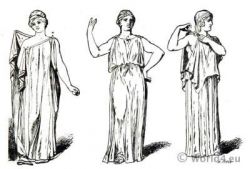-
News
Greece - History
-

The Architecture of Minoan Civilization
16-02-2013 18:54During the development of the first important civilization of the Bronze Age, the Minoan civilization in Crete, we can see the establishment of the organised society evolving along with new tools, crafts and therefore the construction of major urban centres around Palaces following a pattern of architecture.
Some of the most important Minoan monuments on Crete include the Palace of Knossos, the Palace of Malia, the Palace of Phaistos, the villas at Hagia Triada and the remnants of a town at Gournia. The most important Minoan site outside Crete is the excavations of the settlement of Akrotiri on Santorini, where there have been brought to light some of the finest Minoan artworks and frescoes. The construction of the Minoan Palaces begins after 1950 BC and comes to an end at about 1400 BC probably by an invasion to Crete by Mycenaean Greeks from the mainland.
Minoan architecture in general lacks a sense of organization, though the constructions are large complexes like that of the Palace of Knossos that extends an area of 150 by 100 meters. The major source of information concerning the architecture of the early Palaces is the Old Palace at Phaistos, although it is not the earliest of the Minoan Palaces. However, the grandeur of the Palace of Knossos is unsurpassed.
The common features of the Minoan Palaces are the fact that the Palaces are located on high land overlooking the surroundings and the sea. The most remarkable feature though is the absence of fortifications and walls around the Minoan sites, assuming that the Minoans could trust for defense to their sea power. The core of the extensive complexes of buildings is a rectangular square (West Courts) and the several buildings are built around it. The Palaces were the administrative centers, the seat of the ruler and home to a network of craftsmen and trading. The paved streets with walkways and the several rooms along it indicate a busy market.
While each of the Palaces at Knossos, Phaistos, Galatas, Zakros, and Malia is unique, they share a specific set of architectural features, such as door partitions and columns to support buildings of two or three floors. The columns used to be wooden and have a distinctive shape as their bases are smaller than their capitals, usually painted red or white. There was also an extensive underground network of water supply and drainage using pipes of clay, while the interior rooms used a system of air wells to bring light and ventilation.
The walls were covered with a thick layer of plaster forming a smooth surface that is extensively decorated. The decorative motifs in Minoan world are taken of everyday life activities, animals and flowers and are depicted in frescoes with vivid colors. A significant theme is also the athletic performances of young men on bulls and women serving probably like priestesses. The same kind of decoration is extensively used also on pottery which can be seen in the Archaeological Museum in Heraklion in Crete.
However, the most important signs are the Double Axes and the bull horns, symbols of power and religious significance.
-
Top bews!
-
Relative articles
















